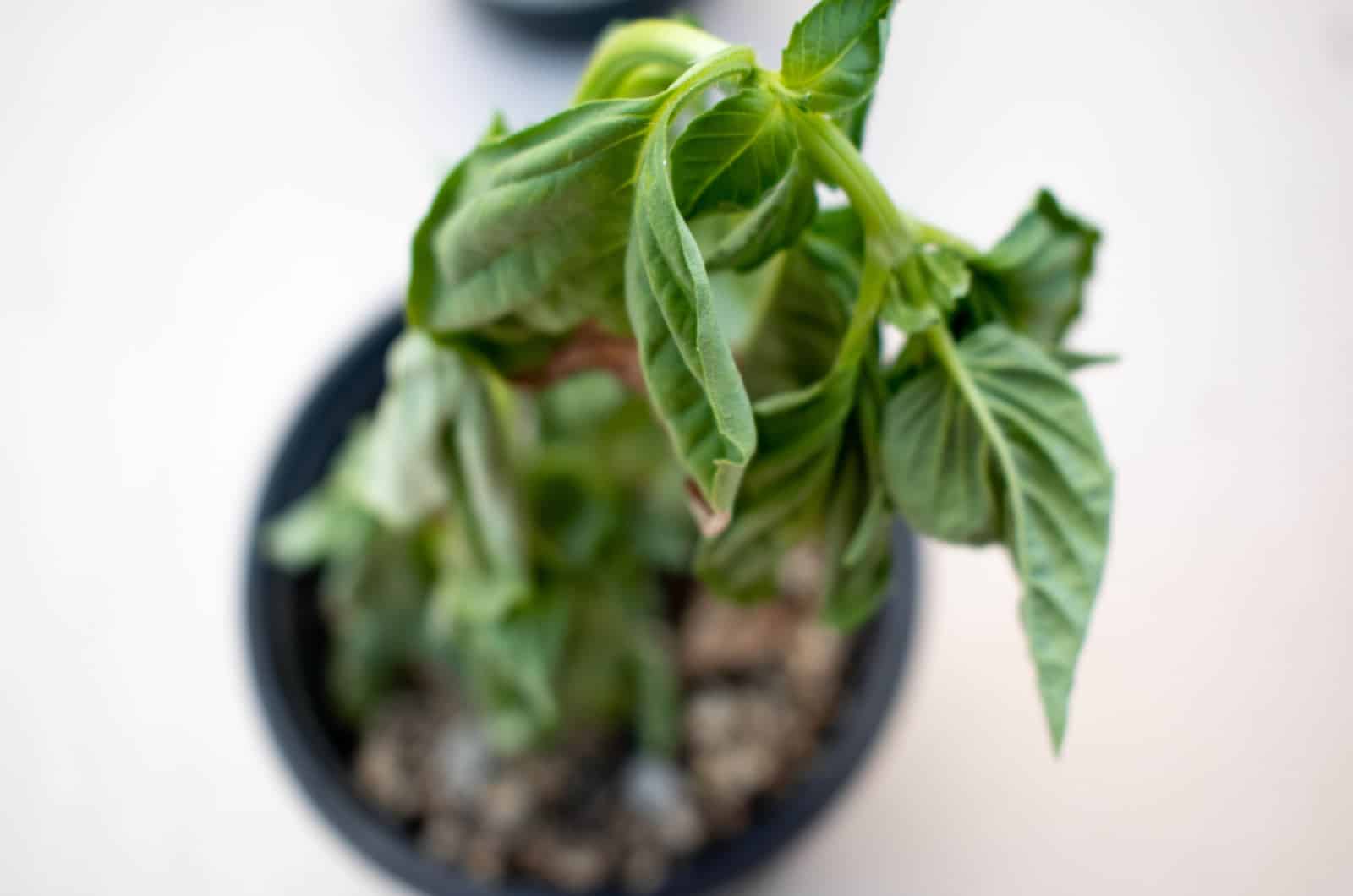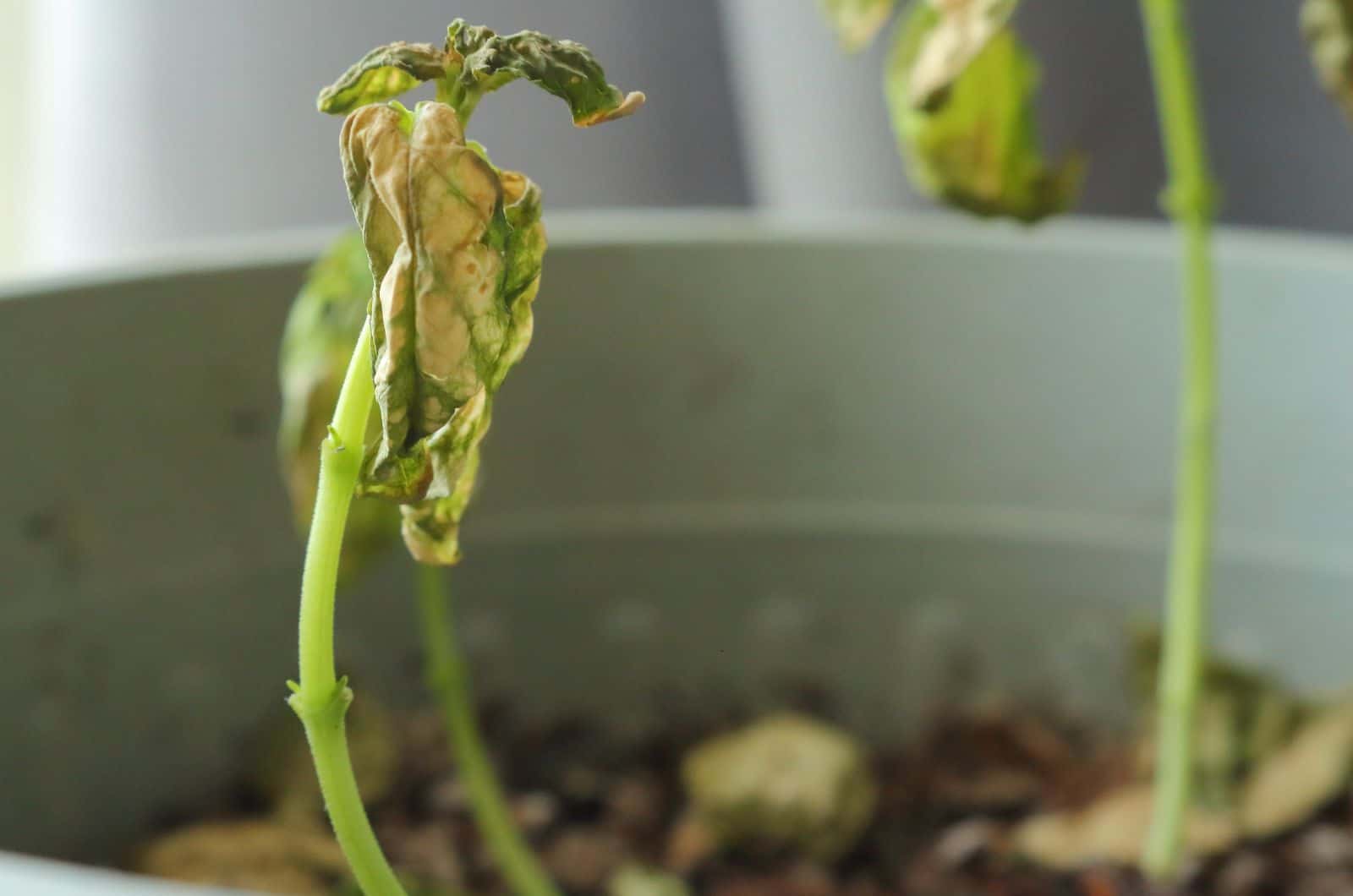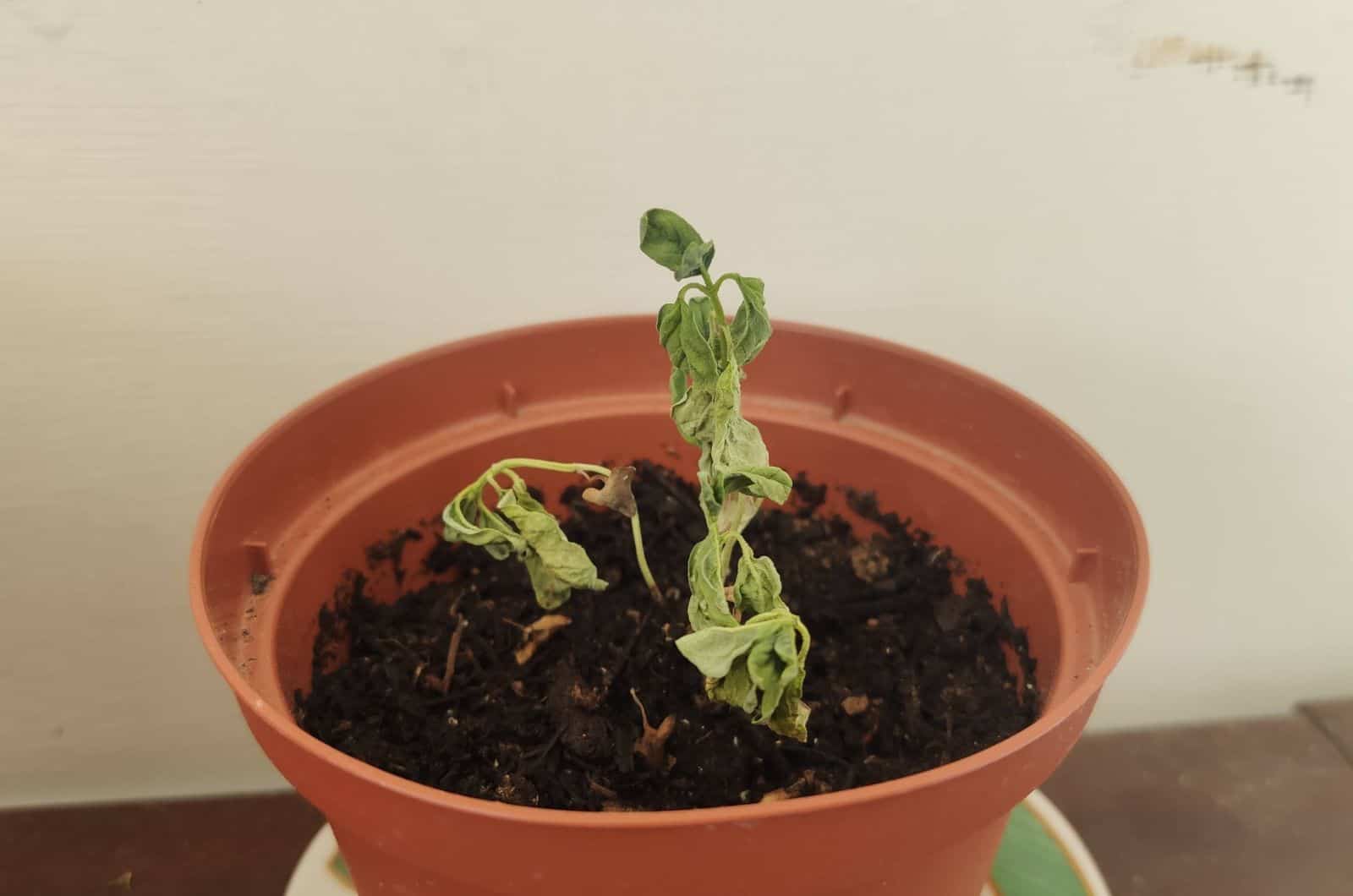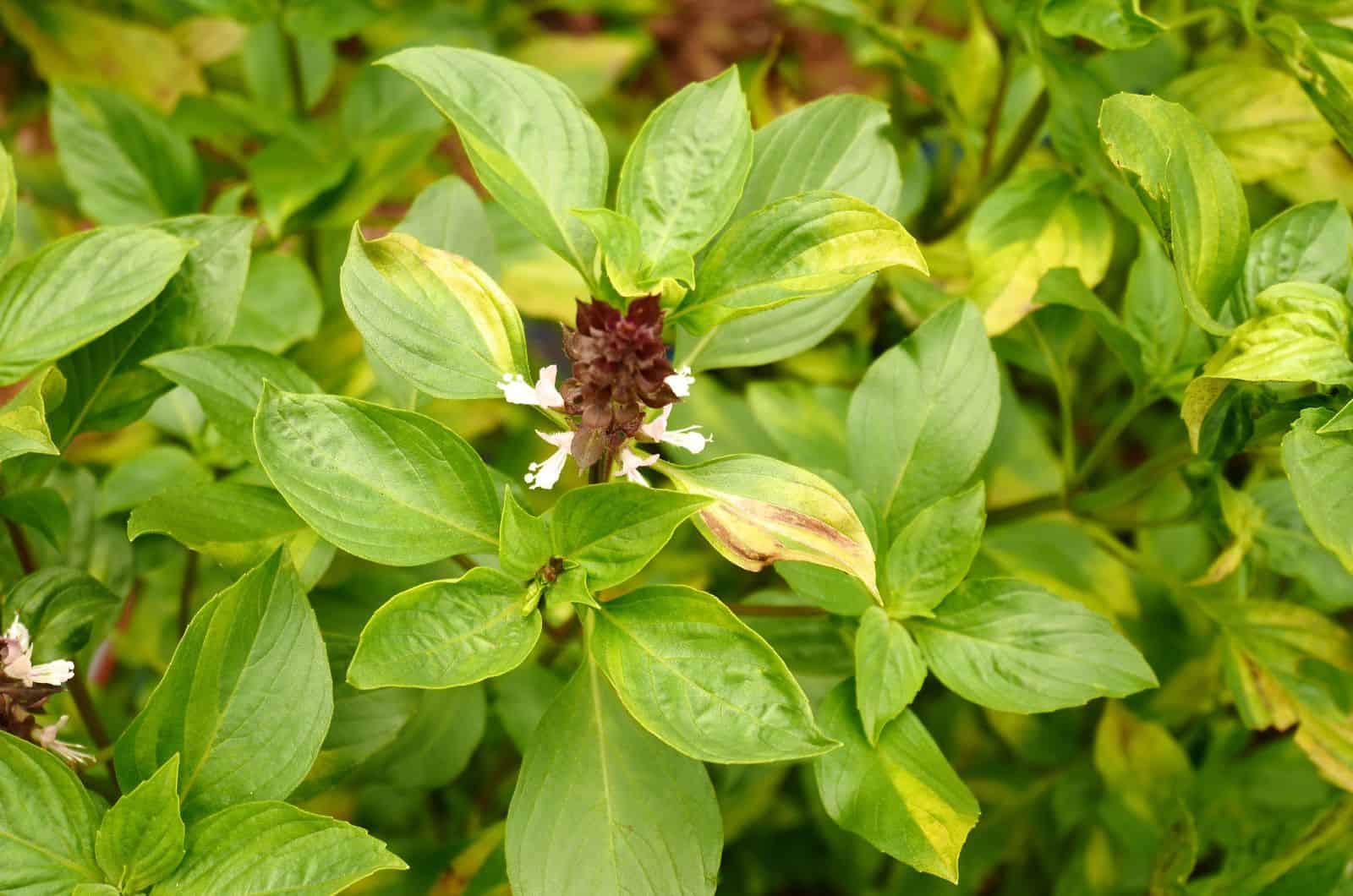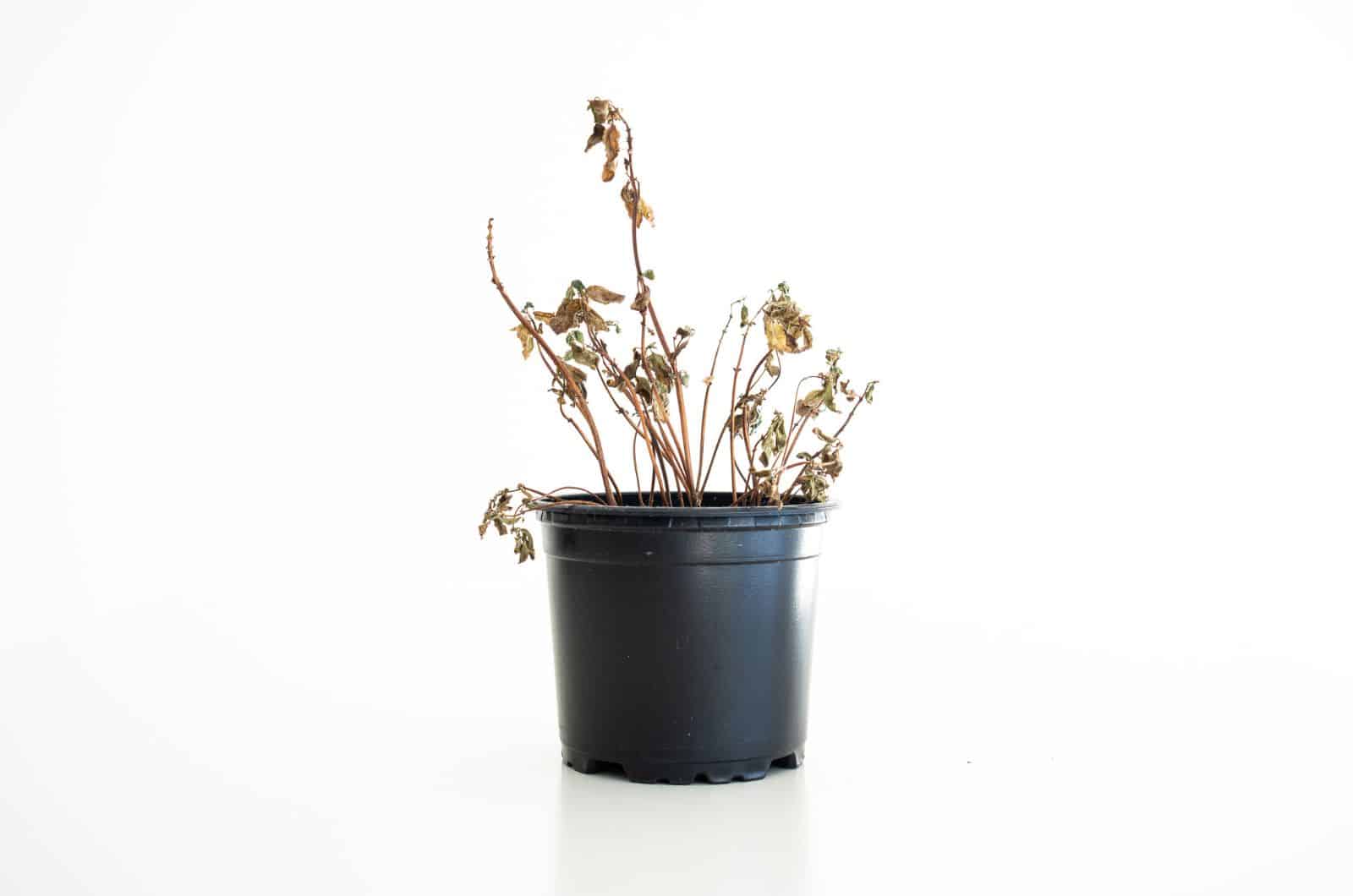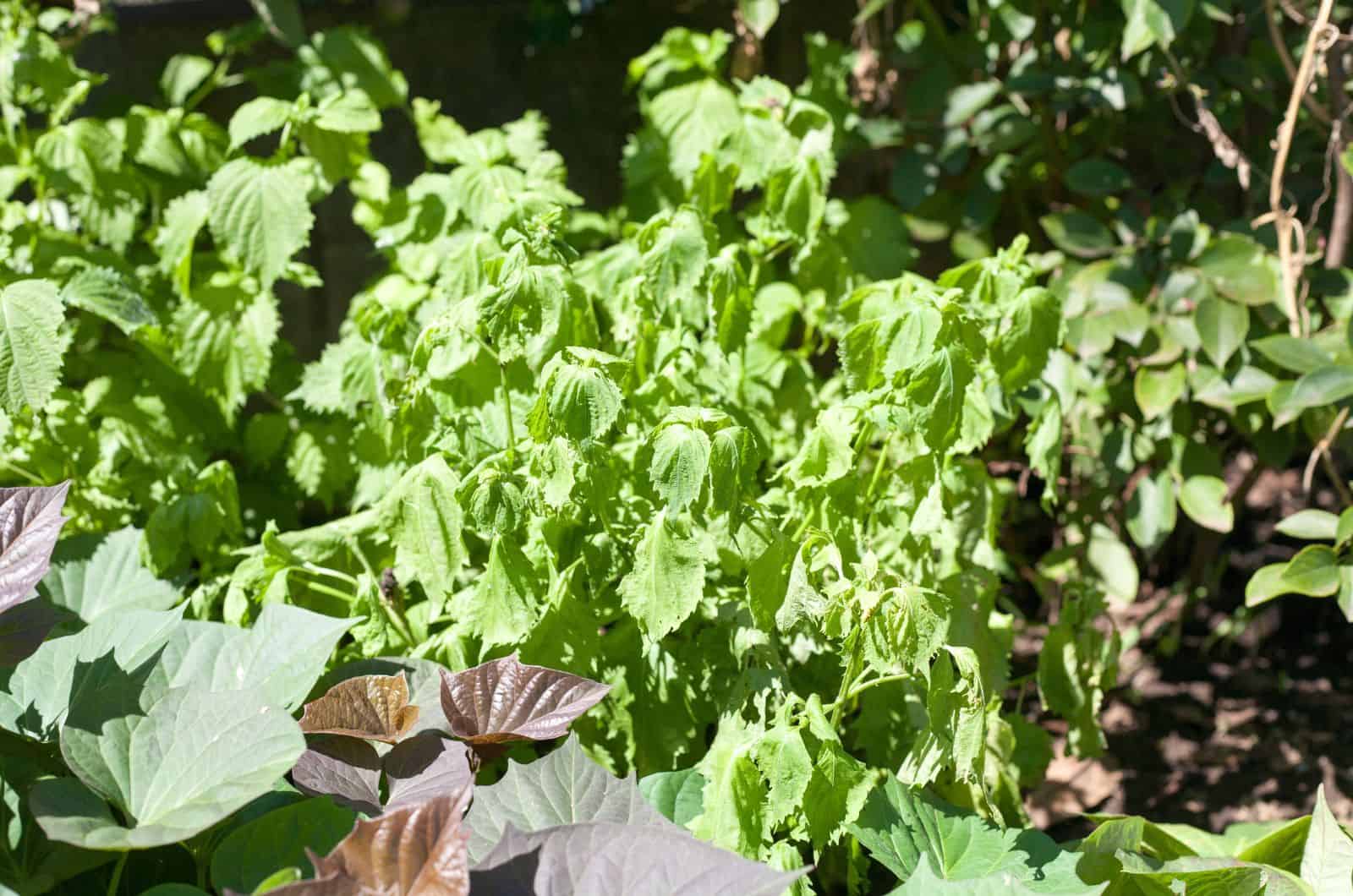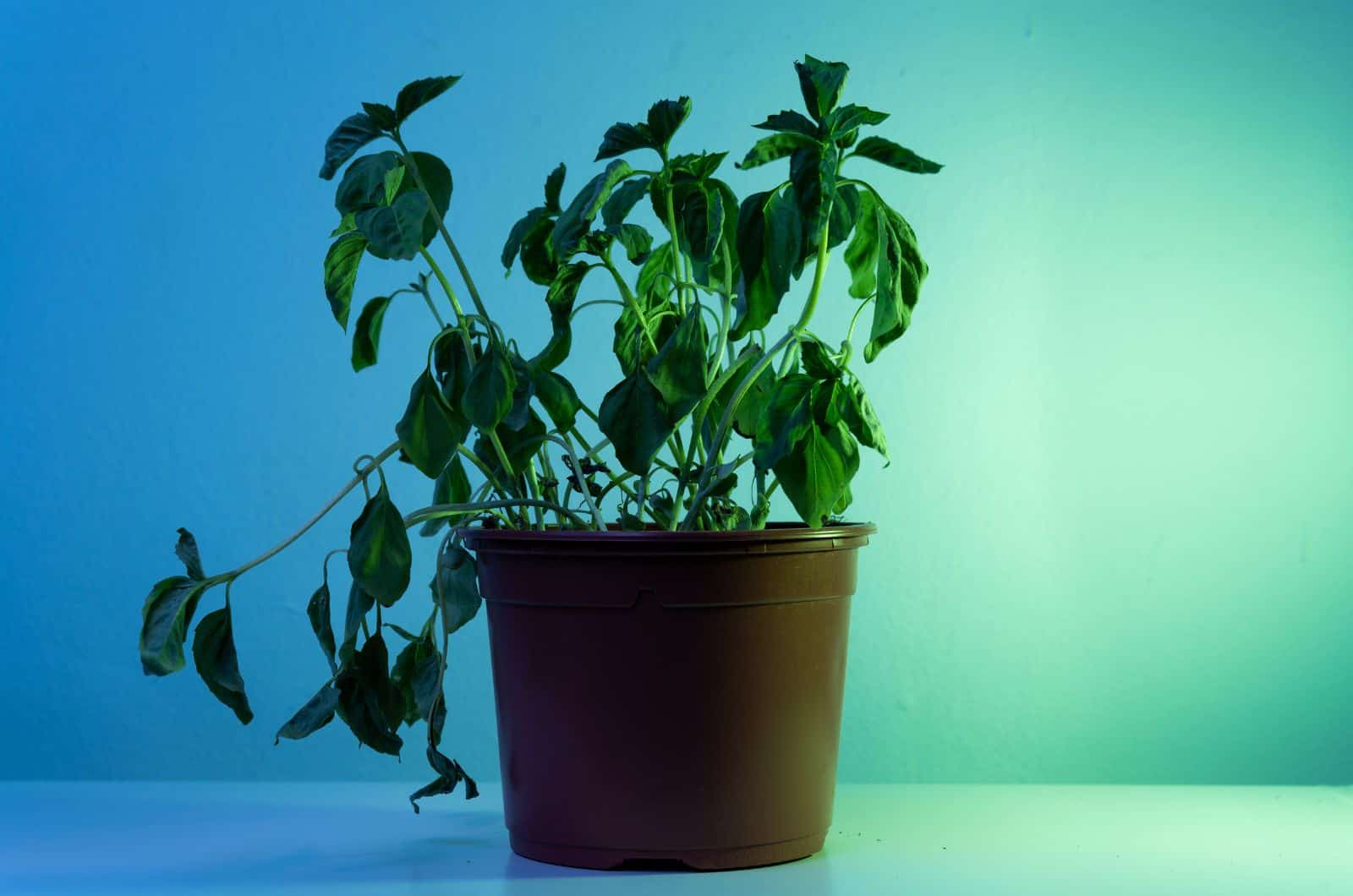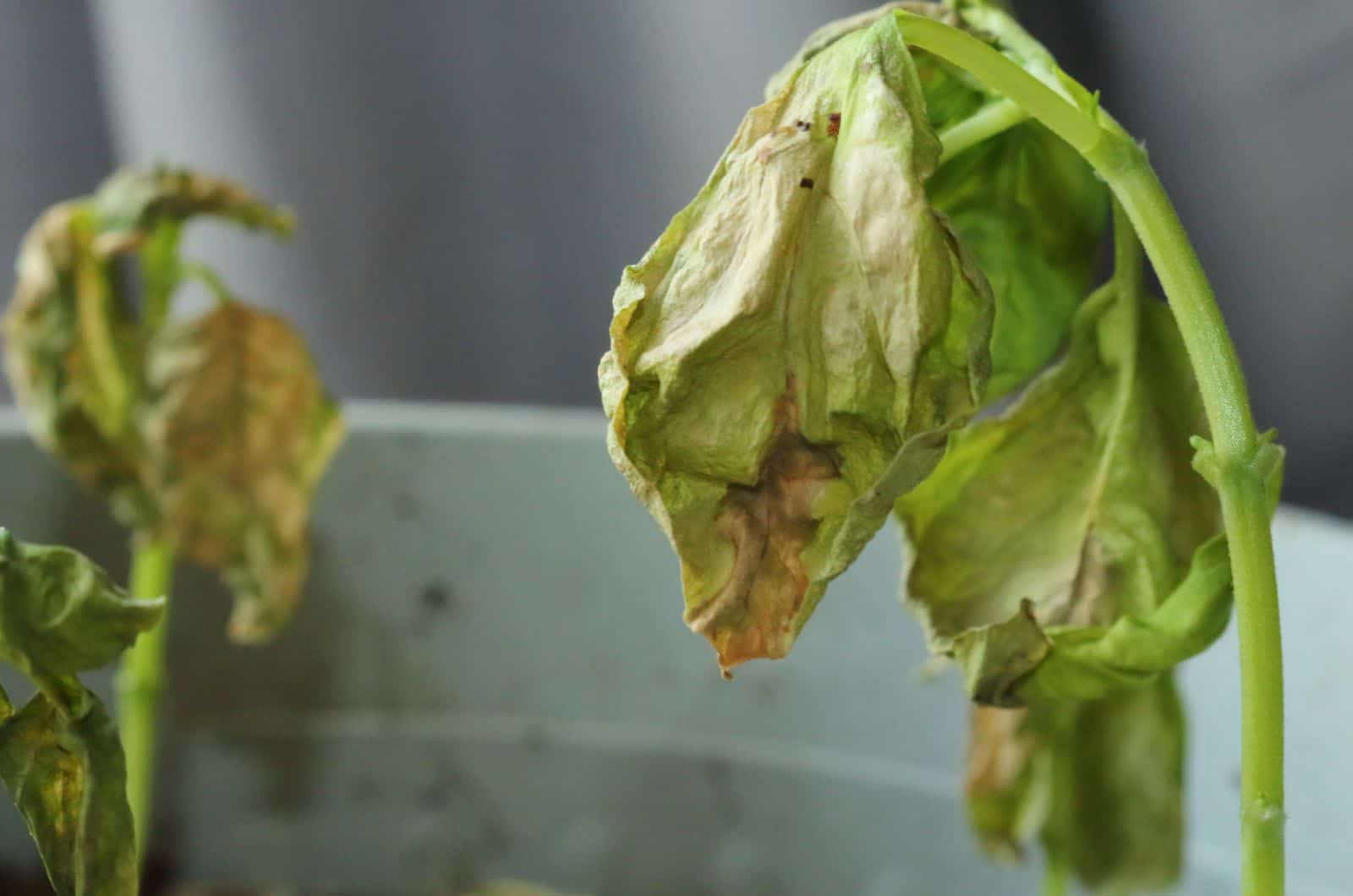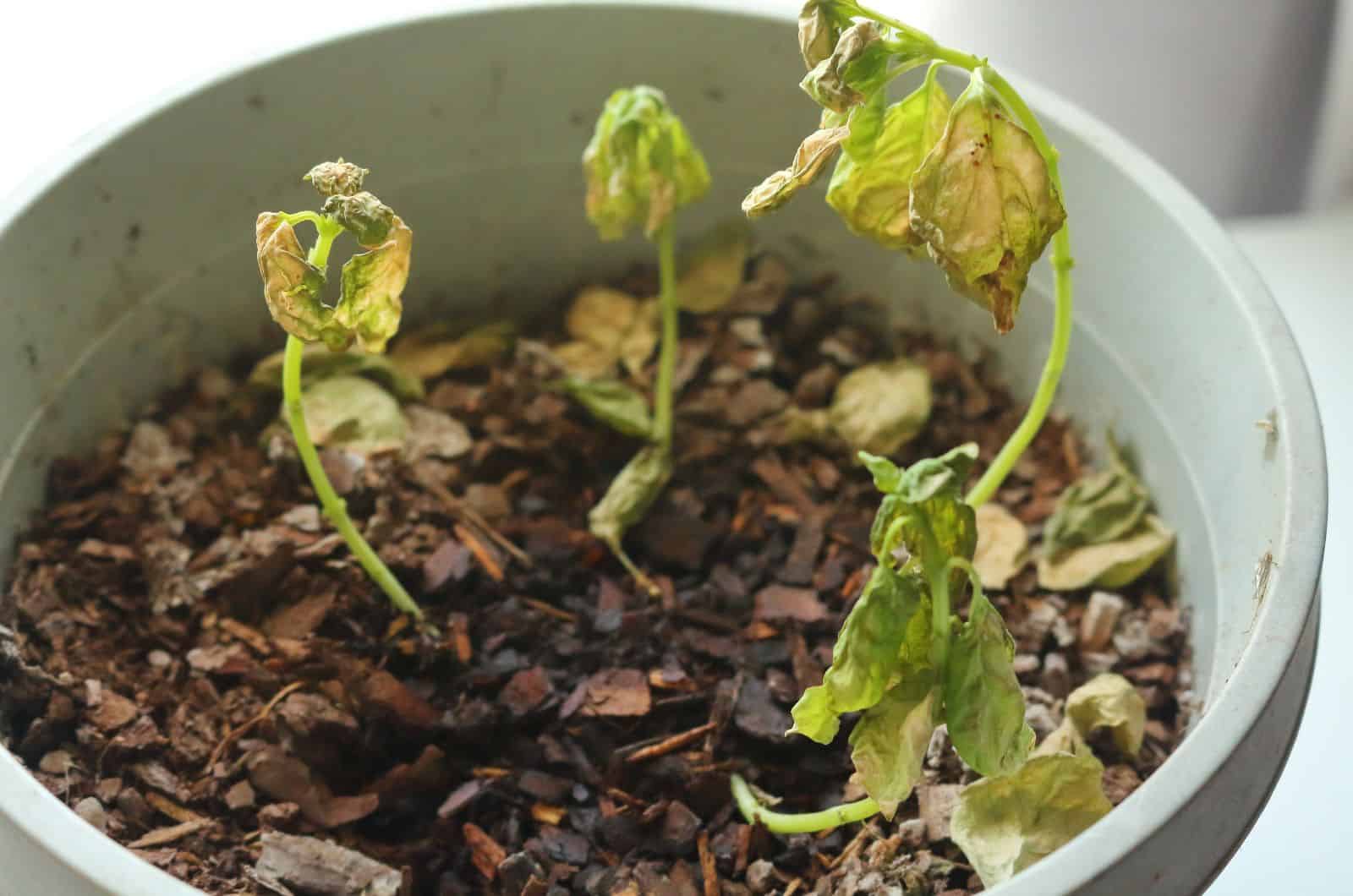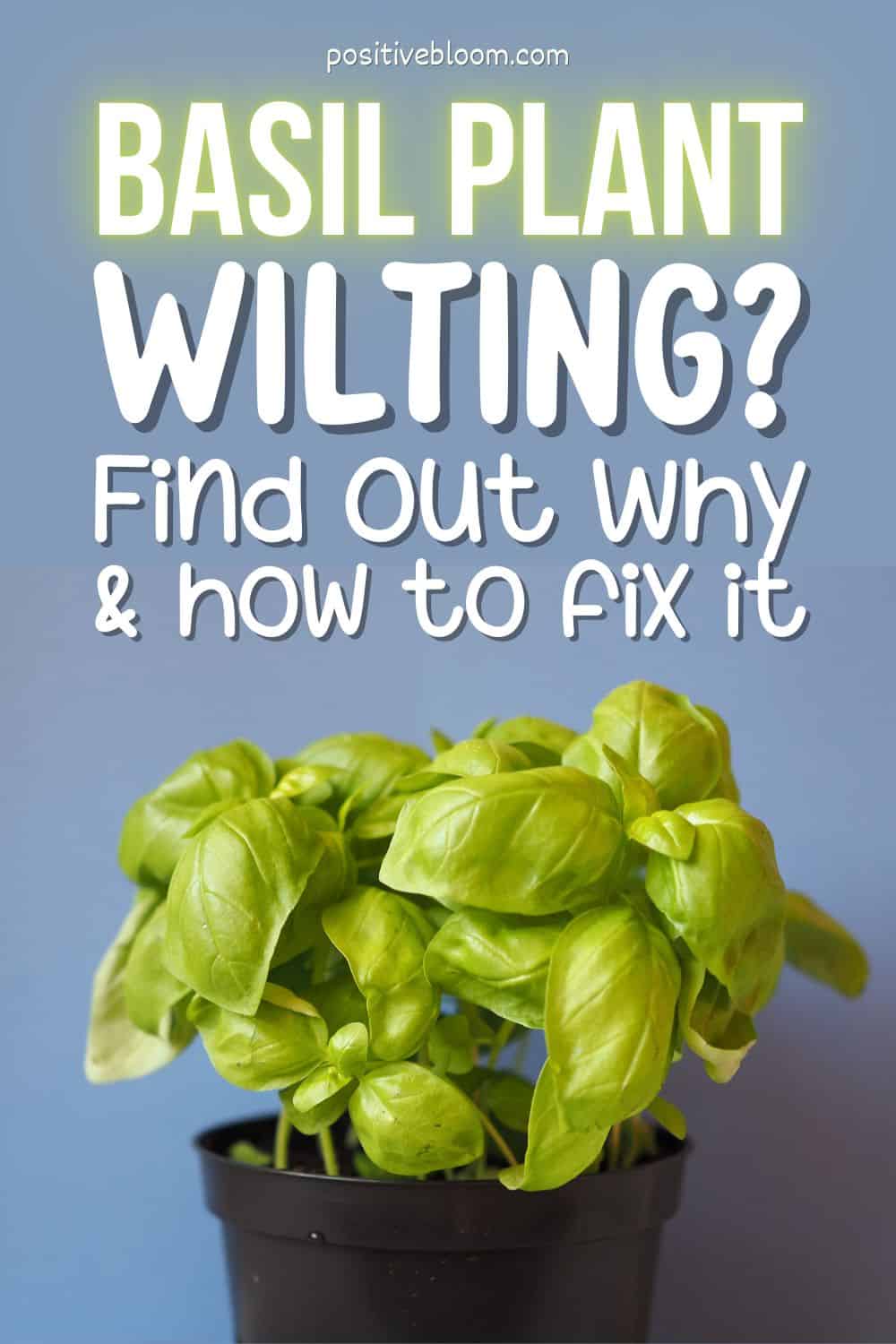I once told my friend that basil is my favorite Italian herb as I thought it was native to Italy; I mean, they use it all the time there. It’s actually Indian, so try to remember that, especially if some of your friends are from India (thank me later).
Growers describe basil as a low-maintenance plant when grown both indoors and outdoors. This is true, but plants aren’t entirely problem-free, and basil isn’t an exception to this.
So, is your basil plant wilting? The reasons for this may vary, some are more serious, and some are completely harmless.
I’ll tell you the most common reason and how to fix the issue (if possible).
Let’s get started!
Basil Plant Wilting: Causes And Solutions
Wilting basil may indicate a few issues, such as watering, diseases, pests, light, transplanting, or temperature. But, your basil may display wilting as part of its life cycle.
So, don’t rush to conclusions until you find out everything!
Let’s get into the details!
Cause: Underwatering
The most common cause of plants wilting is a lack of water. When the soil of your basil doesn’t get enough water, the roots don’t have enough to absorb.
Why is this important? The roots send water and food to other basil plant parts. So, when the roots are left without water for an extended period, they can’t send the nutrients.
The leaves are the first part of the plant to show that your basil is underwatered. You’ll notice that the leaves are turning yellow, and if untreated, they become entirely brown.
This is extremely dangerous, as once the basil leaves turn brown, they’ll fall off, and the plant will wilt.
Another change on the leaves may also indicate underwatering; if the leaves are curling, they are trying to keep as much water as possible. In other words, their surface is reduced as a response to underwatering.
When the soil lacks water, it’ll be pulled from the pot’s edges. Also, the soil will be light brown, an early indicator of underwatering.
Solution To Underwatering
All watering issues may be easily solved by creating an adequate watering schedule. Well, such a thing as a perfect watering schedule doesn’t exist, in that watering basil every Saturday at 5 p.m shouldn’t be something to rely on.
A better definition is to check the basil soil regularly and be consistent. Why? Many conditions affect the soil moisture content, so sometimes you’ll need to water more or less.
Additionally, the watering needs to change based on seasons, and don’t let the soil dry between waterings.
For example, if your basil receives more light, the soil moisture content needs less time to dry out. Therefore, you should water more frequently. The same goes for temperatures; we drink more water when the temperatures are warmer. Plants also need more water in these situations.
If your basil grows in lower humidity, the soil will need more time to drain, so you don’t need to water it as often.
Basil is a shallow-rooted plant, meaning that it needs more water when compared to other veggies.
Therefore, the key to a good ‘watering schedule’ for basil plants is to check the soil moisture.
How To Check Soil Moisture Content
Checking soil moisture won’t take up much of your time; it’s simple and, as such, should be done regularly.
When should you water basil plants? First, check the basil soil’s color; if it’s darker, you should wait for a little while before adding more water.
You can also put your finger in the soil; yes, it’s a dirty technique, but it helps. If you are a beginner grower, you might not be able to determine the moisture content in the beginning. Still, as time passes and you gain experience, this will become a pretty reliable method.
You can always combine this method with observing the soil color.
If you are unsure, you can purchase a moisture meter and you can find these on Amazon, it will help you to detect the moisture content precisely.
Cause: Overwatering
Another very common reason for wilting basil is overwatering. It might sound odd that too much water can cause wilting, but it really can.
Again, it all starts with the roots. One of the easiest ways to overwater your basil (no, it isn’t pouring too much water at once) is watering soil that doesn’t have good drainage.
A soil that is made of materials that retain water well allows excess water to stay around the roots for too long. As you may assume, the basil roots suffocate. The excess water prevents air circulation and makes the soil compact, reducing the oxygen level.
When the roots stop functioning, the leaves can’t receive water. The first sign of overwatering is yellow leaves that wilt if you don’t solve the issue.
Besides yellow leaves, overwatered basil will have mushy soil with a foul odor. You’ll also notice that your basil starts producing flowers.
Remember, you should keep the soil moist, but if you add more water to already wet soil, you’ll be in bigger trouble.
Solution To Overwatering
The biggest problem with overwatering is that it increases the plant’s susceptibility to fungal infections. These fungi adore moist areas, and when they inhabit the soil, they’ll most likely cause root rot.
The best solution is to repot your basil. Even if the damage isn’t severe, I highly recommend repotting, as these harmful fungi spread really quickly.
Prepare fresh soil, a garden trowel, a fungicide, sanitized scissors/pruners, and a new pot.
First, you’ll need to remove your basil from the container. Gently take it out, paying attention not to break any part of the plant.
At this point, you won’t see the roots, so you’ll need to remove the soil that surrounds them. Carefully loosen the soil; if you’re using your hands, please be gentle.
Once the roots are exposed, it’s time to inspect them. The question is, what do healthy roots look like and which ones should you remove?
Each white and firm root is healthy, and you shouldn’t remove or break it. Black, brown, and mushy roots are the diseased ones, and they are the ones that you should get rid of.
With sanitized scissors, remove the diseased roots and apply fungicide to the root system to prevent the disease from spreading.
Place your basil in a new pot filled with fresh soil. Water your basil and give it some time to recover.
Cause: Diseases
There are four diseases that can lead to a basil plant wilting, fusarium wilt, downy mildew, root rot, and leaf spot. We’ve discussed root rot and how to fix it in the previous section. Let’s now find out about the three other diseases.
Fusarium wilt
Fungus Fusarium oxysporum causes a very serious disease that affects basil, fusarium wilt. Your basil may grow well, even if it has this disease, in the early stages of development.
Once the plant reaches about 12 inches in height, it stops growing and starts wilting. Other symptoms of this disease include yellow leaves and brown stems, and the leaves may start falling off.
The main problem with this disease is that it’s transmitted pretty quickly, which brings danger to other plants, as the spores are airborne.
It stays in the soil for a long time; if you are growing your basil outside, you’ll need to destroy it and wait for a couple of years until planting it again.
Also, this disease can be seed-borne, so you should pay attention when purchasing seeds.
Downy mildew
Downy mildew disease is the most common disease when it comes to basil. The first thing that you’ll notice if your basil suffers from downy mildew is yellow leaves that eventually turn brown.
You’ll also notice your basil plant drooping, wilting, and developing fuzzy growth on its leaf undersides.
This disease also spreads quickly, and other plants can easily get it.
What causes downy mildew? If your basil is growing in high humidity, the chances of getting this disease increase.
Leaf spot
This is another fungal disease, and it is caused by Pseudomonas spp. or Xanthomonas. It affects the leaves, so if you notice brown spots, wilting, and falling of the leaves, check for this disease.
The most common cause of leaf spot disease is wet leaves or waterdrops on the leaves after watering.
Solution To Diseases
Unfortunately, downy mildew and fusarium wilt can’t be cured. The fungi that cause these diseases remain in the soil for a long time, so you should concentrate on recovering the soil.
You’ll need to discard the plants that are affected by these diseases.
The best option is to start growing other basil varieties, such as lemon or purple basil.
If you grow basil indoors, discard both plant and soil; wrap them in a paper bag, and dispose of them in the trash can.
Luckily, leaf spot disease can be cured by removing the affected leaves. The best way to prevent this disease is to water at the base of the plant. Remember that the leaves should always be dry!
Cause: Pest Infestation
Basil isn’t attractive to only humans; pests like aphids and spider mites also find this fantastic herb attractive.
It’s essential to spot the early signs of infestation, before the wilting occurs.
Spider mites
Basil is a big fan of hot weather, but the bad news is that spider mites are too! When spider eggs inhabit the plant’s soil, they’ll thrive in dry conditions.
It’s almost impossible to spot spider mites if you don’t use a magnifying glass. When observing your basil, search for tiny black spots, especially on the undersides of the leaves.
Also, if there’s webbing on the basil leaves and the plant starts wilting, you are dealing with a spider mites infestation!
Aphids
Aphids are tiny pests that usually leave sticky substances on the leaves. Even though they are tiny, these nasty creatures cause serious damage to basil.
Yellowing and curling of the leaves usually appear with a sticky substance. Severe infestations usually result in wilting.
Solution To Pests
It’s essential to get rid of the pests before they take over your plant(s). There are many DIY recipes that you can use to get rid of both spider mites and aphids.
First, you can try removing as many aphids or spider mites as you can using your hands. If the infestation isn’t severe, this may be the only thing that you’ll need to do.
I know it’s not a pleasant feeling to collect the bugs, so if you don’t like picking them off manually and crushing them, there are other methods.
If you determine that spider mites have infested your basil, moist soil should deter them. Frequent watering may help you to eliminate these pests (be careful not to overwater your basil though!).
If you grow basil outdoors, try to remove pests using a garden hose. You can get rid of these pests completely if you spray them off for the first couple of days.
Insecticidal soap and neem oil also have a high success rate in fighting pests.
If none of these methods work, try chemical pesticides.
Cause: Temperature Fluctuations & Light Issues
Basil adapts well to different growing conditions but can’t withstand sudden temperature (or any other) changes.
If the nighttime or daytime temperature suddenly drops or increases, your basil will respond by wilting.
Lower temperatures cause wilting, leaf curl, and brown leaf edges. This is very frequent during winter when the difference between nighttime and daytime temperatures is quite different.
Remember that the basil plant has shallow roots, so even a little bit of frost may quickly kill it.
Another very common cause of wilting is an inappropriate light level. Basil can be described as a sun-loving plant, but too much direct sunlight may damage the leaves and result in wilting.
Solution
The best way to solve temperature problems is to keep the thermostat at 70 degrees Fahrenheit. Slightly higher or lower temperatures won’t harm your basil. However, if the temperature drops below 50 degrees Fahrenheit, your basil will be in danger.
I recommend adding mulch to the soil to help your basil stay warm during colder months.
It’s easier to control temperatures and light indoors, so if you are growing basil indoors, don’t place the pot directly on the window sill during summer.
Also, make sure that your basil isn’t near air conditioners, vents, fireplaces, or radiators.
Cause: The Pot Is Too Small
We don’t think much about a pot’s size and material when we start growing plants. We mainly choose them according to appearance.
But if your basil is growing in a small pot, its roots won’t have enough space to grow; they’ll stop functioning and won’t send water or nutrients to the leaves.
Remember that we said that a lack of water causes the leaves to turn yellow and wilt? That’s exactly what’s happened here.
Solution
You’ll obviously need to repot your basil into a larger pot. But the pot size isn’t the only thing that matters; the materials that the pot is made out of also play a significant role.
I recommend growing basil in terracotta pots as the plastic ones absorb the heat from the full sun.
This means that the soil will need less time to dry out, and your basil can be left without water.
Terracotta pots retain moisture but aid in drainage at the same time. Alternatively, use ceramic or clay pots.
If you aren’t satisfied with the look of the pot, you can always purchase a cache pot and place the not-as-good-looking one into it.
One more thing; the perfect pot for basil plants must have drainage holes!
Cause: Basil Is Flowering
The last thing that we think after we have noticed that our basil is wilting is that it’s completely normal.
Your basil plant may start wilting once it starts flowering. The life cycle of an annual herb is to reach maturity and then start flowering to develop new seeds. After the growing season is over, basil displays wilting.
After that, the plant dies off. So, don’t worry if you notice flowering, nothing is wrong with your basil, and if you want it to stop flowering, there are some ways to achieve this.
Solution
As you may know, the basil tips produce flowers, so in order to prevent flowering, remove those tips.
If your basil has already produced flowers, you should remove them, unless you want your plant to wilt and die once it’s done producing the seeds.
The flowers need energy to produce seeds, and by removing the flowers, you’ll allow the plant to use energy to develop new leaves instead.
I cut off the upper half of my basil plant to encourage new growth.
Cause: Transplant Shock
When basil adapts to certain growing conditions, it’s pretty hard for it to adjust to new ones.
For example, you grow your basil in a certain spot, and then you suddenly relocate it to an area where it receives more light or less humidity.
Or, if you are growing basil indoors and you want to move it to your backyard and you repot it first.
What happens is that a repotted basil needs time to adapt to new soil. If you additionally transfer the pot outside, your basil will be stressed and will respond by wilting.
Solution To Transplant Shock
There’s no magic potion that’ll help your basil adapt faster. The best option is to gradually introduce basil to outdoor conditions.
For instance, place the pot in partial shade in your garden and let it grow there for a week or two.
In this way, your basil will receive a lot of light and will adapt to direct sun easily.
You should also pay attention when repotting your basil. First, prepare well-draining soil and a new pot. The pot for your basil should be slightly larger, as the roots will need more moisture until they have fully adapted.
The larger the pot, the more soil it contains, but if the new basil pot is too large, the soil moisture content will be too high, so the roots will have too much water around them.
Don’t expect the droopy leaves to become healthy quickly. It takes time for your repotted basil to recover.
Avoid feeding basil until it fully adapts to its new conditions.
What Is The Best Way To Avoid A Wilting Basil Plant?
So, how do you grow a healthy basil plant? Here’s a table that shows you the perfect conditions that your basil will thrive in.
| Light conditions | If you grow basil outdoors, it requires about 6 hours of full sun daily. When grown indoors, basil needs bright light. Remember that basil plants don't respond well to low light, so consider getting grow lights. |
| Temperature conditions | Keep the temperature above 50 degrees Fahrenheit. The best option is to plant your basil once the temperatures rise above 70 degrees. |
| Humidity conditions | The ideal humidity for basil plants is around 60%. High humidity changes the watering needs of this plant, so check the soil regularly. |
| Soil requirements | This plant requires well-draining but moist soil. I recommend adding mulch or compost to ensure its nutrients. |
| Watering | Add about an inch of water weekly; if you grow basil indoors, bear in mind that it will need more frequent watering. |
| Fertilizing | If you grow basil outdoors, additional food isn't a must. If you decide to fertilize it, use a balanced, liquid fertilizer and apply it monthly during the growing season. Pay attention to dosage and always read the instructions before applying any type of fertilizer. |
| Pruning | You can prune off the upper leaves (from the plant's tips) to encourage new growth. |
| Harvesting | To get fresh basil during summer, harvest it monthly; cut off around 1/3 of the leaves and add it to your favorite dishes or save some for winter! |
Wrapping Up
When growing low-maintenance plants, we don’t expect them to have any issues. But nothing is perfect and completely problem-free, especially when it comes to plants.
Basil is one of my favorite herbs, and I could literally add it to any meal.
Now that you know the reasons for a basil plant wilting, use our tips to make it happy and healthy again!
Until next time!
Like this post? Share or pin it for later!

